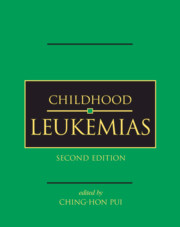Book contents
- Frontmatter
- Contents
- List of contributors
- Preface
- Part I History and general issues
- Part II Cell biology and pathobiology
- Part III Evaluation and treatment
- Part IV Complications and supportive care
- 29 Acute complications
- 30 Late complications after leukemia therapy
- 31 Therapy-related leukemias
- 32 Infectious disease complications in leukemia
- 33 Hematologic supportive care
- 34 Pain management
- 35 Psychosocial issues
- 36 Nursing care
- Index
- Plate Section between pages 400 and 401
- References
34 - Pain management
from Part IV - Complications and supportive care
Published online by Cambridge University Press: 01 July 2010
- Frontmatter
- Contents
- List of contributors
- Preface
- Part I History and general issues
- Part II Cell biology and pathobiology
- Part III Evaluation and treatment
- Part IV Complications and supportive care
- 29 Acute complications
- 30 Late complications after leukemia therapy
- 31 Therapy-related leukemias
- 32 Infectious disease complications in leukemia
- 33 Hematologic supportive care
- 34 Pain management
- 35 Psychosocial issues
- 36 Nursing care
- Index
- Plate Section between pages 400 and 401
- References
Summary
Principles of pain management for children with cancer
In identifying and treating pain in children with cancer, one must keep in mind the complexity of pain as a physiological, psychological, and social phenomenon. The etiology of pain in the cancer patient is diverse. Children with cancer experience pain associated with the disease, pain caused by procedures to establish a diagnosis and monitor the disease, and pain related to therapeutic interventions (postoperative pain or pain related to chemotherapy or radiotherapy). Because of the multitude and complexity of factors involved in the pathogenesis of pain in children with cancer, the diagnostic and therapeutic strategies for pain management need to be individualized to the particular needs of each patient. The treatment plan most often includes multiple pharmacologic and nonpharmacologic interventions delivered by a multidisciplinary team that includes pediatricians, oncologists, anesthesiologists, nurses, psychologists, child life specialists, and physical therapists. The principles of pain management for children with cancer are presented in Table 34.1.
Assessment of pain
Before pain can be successfully managed or controlled, it must first be assessed using tools that are age appropriate and well suited to the clinical situation. In assessing pain, the health care provider should always assume that the child's report of pain is valid. Self-report is the gold standard for assessment of pain. For infants, toddlers, or children who cannot self-report, the FLACC (face, legs, activity, cry, consolability) Scale is recommended (Table 34.2) and has received clinical validation. Each component is scored separately, and these scores are summed to determine the FLACC score.
- Type
- Chapter
- Information
- Childhood Leukemias , pp. 850 - 857Publisher: Cambridge University PressPrint publication year: 2006



